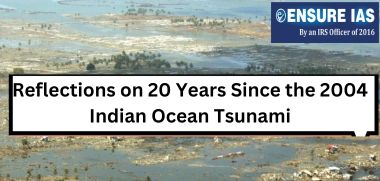- Courses
- GS Full Course 1 Year
- GS Full Course 2 Year
- GS Full Course 3 Year
- GS Full Course Till Selection
- Answer Alpha: Mains 2025 Mentorship
- MEP (Mains Enrichment Programme) Data, Facts
- Essay Target – 150+ Marks
- Online Program
- GS Recorded Course
- Polity
- Geography
- Economy
- Ancient, Medieval and Art & Culture AMAC
- Modern India, Post Independence & World History
- Environment
- Governance
- Science & Technology
- International Relations and Internal Security
- Disaster Management
- Ethics
- NCERT Current Affairs
- Indian Society and Social Issue
- NCERT- Science and Technology
- NCERT - Geography
- NCERT - Ancient History
- NCERT- World History
- NCERT Modern History
- CSAT
- 5 LAYERED ARJUNA Mentorship
- Public Administration Optional
- ABOUT US
- OUR TOPPERS
- TEST SERIES
- FREE STUDY MATERIAL
- VIDEOS
- CONTACT US
Reflections on 20 Years Since the 2004 Indian Ocean Tsunami
Reflections on 20 Years Since the 2004 Indian Ocean Tsunami
28-12-2024

- December 26, 2024, marks 20 years since the devastating Indian Ocean tsunami, triggered by a magnitude 9.1 earthquake that struck 30 km below the ocean floor in the Sunda Trench.
- This region, where the Indo-Australian plate subducts beneath the Burma microplate—a part of the Eurasian plate—was the epicenter of a disaster that impacted 17 countries across the Indian Ocean.
- The tsunami killed over 227,000 people, displaced thousands, and caused widespread destruction.
- Regions severely affected included India (especially Tamil Nadu and the Andaman and Nicobar Islands), Indonesia, the Maldives, Sri Lanka, and Thailand.
- This catastrophic event served as a wake-up call for the global community, leading to significant advancements in tsunami science, disaster preparedness, and resilience-building efforts.
What is Tsunami?
- Definition: Tsunamis are a series of waves caused by a sudden displacement of the ocean.
- Causes:
- Large undersea earthquakes (most common trigger).
- Landslides, volcanic eruptions, meteorite impacts, and certain weather conditions.
- Common Areas:
- Occur frequently along fault lines, particularly around the Pacific Ring of Fire.
- 69% of tsunamis are in the Pacific Ocean.
- Unique Triggers: Tsunamis can also occur due to remote landslides and volcanic eruptions far from coastlines.
Tsunami Science and Preparedness in India
Early Challenges
- Before 2004, India’s preparedness was minimal despite earlier tsunamis, such as the 1881 Car Nicobar earthquake and the 1883 Krakatoa eruption.
- The scale of the 2004 disaster revealed gaps in disaster management and the need for scientific advancements.
Key Developments Since 2004
- Indian Tsunami Early Warning Centre (ITEWC): Established in 2007 at the Indian National Centre for Ocean Information Services (INCOIS), Hyderabad to detect tsunamigenic earthquakes and issue timely warnings.
- Operates seismic stations, bottom pressure recorders, and tidal stations for real-time monitoring.
- Can issue alerts within 10 minutes of detecting a potential tsunami-triggering earthquake.
- Enhanced Early Warning Systems: Developed a state-of-the-art Tsunami Early Warning System (TEWS), operational since 2007.
- Integrates data from seismic stations, tide gauges, and deep-ocean tsunami detection buoys.
- Around 150 stations present globally, including Deep-ocean Assessment and Reporting of Tsunamis (DART) buoys that monitor pressure changes on the seafloor to detect tsunamis.
- Improved Technology: Advancements in technology have significantly reduced the time required to detect and model tsunamis from 50 mins to just 5-7 mins with the help of modern algorithms and faster supercomputers.
- Increased Monitoring Stations: Increased global sea-level monitoring stations from 1 in 2004 to over 14,000 today.
- Real-time Data Sharing: Ocean monitoring systems provide critical offshore and deep-ocean tsunami observations. India became the 5th country with such advanced capabilities, joining the U.S., Japan, Chile, and Australia.
- Community Preparedness: Regular workshops, mock drills, and public education programs by INCOIS.
- UNESCO-IOC’s ‘Tsunami Ready’ program promotes coastal community awareness and readiness through a structured approach.
- Policy and Institutional Reforms:
- Enactment of the Disaster Management Act, 2005.
- Formation of the National Disaster Management Authority (NDMA) to institutionalize disaster response and preparedness.
- State and district disaster management plans integrated disaster risk reduction (DRR) measures into urban planning.
Lessons from the 2004 Tsunami
- Importance of Natural Ecosystems: Mangroves provide natural protection areas and act as natural buffers against waves but have been significantly destroyed for shrimp farming, tourism, and other activities like fuel needs.
- Artificial barriers like brick walls can increase susceptibility to wave damage.
- Public Commons and Economic Impact: Keeping coastal areas public is vital for preserving livelihoods and promote community resilience.
- Case study: Privatization of coastlines in countries like Thailand displaced communities, leading to informal labour and economic vulnerabilities.
- Disasters increases Economic Inequalities: Market disruptions post-tsunami resulted in economic inequalities, replacing traditional livelihoods with low-paid labour.
- Mechanized fishing displaced artisanal practices, intensifying resource depletion and ecological damage.
- The tsunami created winners and losers in the market. The tsunami caused prices for rent, land, goods, and services to go up, which only benefited those who owned property or provided services.
- It also hurt local businesses and economies, replacing local products with goods from elsewhere. This forced people to abandon their traditional jobs for low-paying, temporary work.
- Social Inequalities in Relief and Rehabilitation: Vulnerable groups (e.g., labourers, Dalits, women, and minorities) often overlooked in relief efforts.
- Asset-based damage assessments favoured wealthier segments.
- Gender-insensitive policies excluded women from aid distribution. For example, widows in fishing communities couldn't get help because they didn't have official IDs from the fishing department.
- Undocumented migrants faced exclusion, as seen with Burmese and Lao workers in Thailand.
- Local democratic structures, such as fishing community institutions, were undermined by external agencies. For example, fishing communities operate through democratic practices such as kuppams.
- Local Engagement: Long-term engagement with community-based structures is essential for effective disaster management.
- Local knowledge and practices should be respected and integrated into recovery efforts.
- Fishing communities relied on participatory decision-making rather than imposed external systems.
Case Study: Nagapattinam’s Journey to Resilience
Lessons from Nagapattinam and Global Insights
|
Ongoing Challenges and Future Directions
- Evolving Risks: Climate change, urbanization, and the increasing frequency of extreme weather events pose new threats, requiring innovative and adaptive disaster management strategies.
- Sustaining Community Engagement: Maintaining active community participation remains challenging. Continuous education and engagement programs are essential to sustain preparedness.
- Inclusive Policies: Disasters disproportionately affect marginalized groups, including women, children, and differently-abled individuals. Inclusive policies and comprehensive insurance mechanisms are vital to ensure equitable resilience.
- Resource Allocation and Coordination: Efficient resource allocation for recovery and preparedness is often hindered by bureaucratic challenges. Strengthening coordination between NGOs and government agencies can enhance the effectiveness of disaster management initiatives.
- Strengthening Disaster Preparedness: Enhancing early warning systems with advanced technologies like AI and GIS mapping. Expanding multi-hazard shelters and integrating DRR measures into development.
- Research and Technological Innovation: Expanding research on tsunami risks and prediction models is necessary. Utilizing satellite-based remote sensing and machine learning to enhance forecasting accuracy.
Conclusion
The 20th anniversary of the 2004 Indian Ocean tsunami is a moment for reflection. While significant progress has been made in science, policy, and community preparedness, challenges remain. By integrating lessons learned, investing in technology, and ensuring inclusive and community-driven approaches, the global community can build a future where coastal regions are resilient against such devastating disasters. Together, we can transform tragedy into a commitment to safeguard lives and livelihoods.
|
Also Read |
|




